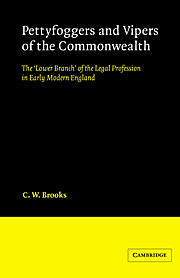 Pettyfoggers and Vipers of the Commonwealth
Pettyfoggers and Vipers of the Commonwealth Book contents
- Frontmatter
- Contents
- List of tables and figures
- Preface
- Abbreviations
- 1 Introduction
- 2 Lawyers and the royal courts in London during the reign of Elizabeth
- 3 The legal profession in the provinces
- 4 The increase in litigation
- 5 The causes of the increase in litigation
- 6 The increase in litigation and the legal profession
- 7 The attitudes of layman and attempts at reform
- 8 Clerkship, the inns of chancery, and legal education
- 9 Private practice
- 10 Public office and politics
- 11 Fees and incomes
- 12 Conclusion
- Appendix: Analysis of the social status of litigants in King's Bench and Common Pleas, 1560–1640
- Notes
- Select bibliography
- Index
- CAMBRIDGE STUDIES IN ENGLISH LEGAL HISTORY
3 - The legal profession in the provinces
Published online by Cambridge University Press: 28 October 2009
- Frontmatter
- Contents
- List of tables and figures
- Preface
- Abbreviations
- 1 Introduction
- 2 Lawyers and the royal courts in London during the reign of Elizabeth
- 3 The legal profession in the provinces
- 4 The increase in litigation
- 5 The causes of the increase in litigation
- 6 The increase in litigation and the legal profession
- 7 The attitudes of layman and attempts at reform
- 8 Clerkship, the inns of chancery, and legal education
- 9 Private practice
- 10 Public office and politics
- 11 Fees and incomes
- 12 Conclusion
- Appendix: Analysis of the social status of litigants in King's Bench and Common Pleas, 1560–1640
- Notes
- Select bibliography
- Index
- CAMBRIDGE STUDIES IN ENGLISH LEGAL HISTORY
Summary
The early centralization of royal justice and the concentration of the main courts of the realm in the capital city were features of the English legal system which were unique in Europe. Consequently, an account of the English legal profession must inevitably start in London. But having begun in London, it cannot stop there. The royal courts heard cases from every part of the realm. Many of the litigants for whom members of the lower branch acted lived in the country. Most of the lawyers themselves led double lives, one part consisting of residence and private practice in the provinces and the other of termly trips to London for the sittings of the royal courts. The history of the lower branch must, therefore, be written within these same geographical contours.
As the sixteenth century wore on, there was a tendency for practitioners such as the six clerks in Chancery or the officials in the court of Wards, men who were concerned mostly with issuing procedural writs, to dwell full-time in the City. But this was by no means common during the early Elizabethan years. As late as 1589, at least twelve of twenty-two officials of the court of Common Pleas had a principal residence in the country, and so too did all of the six clerks in Chancery. If, even for the major office holders, work in London was mainly a term-time affair, this was all the more true for those practitioners such as the attorneys of King's Bench and Common Pleas, whose main function within the legal system was to act as links between men in the country and the royal courts.
- Type
- Chapter
- Information
- Pettyfoggers and Vipers of the CommonwealthThe 'Lower Branch' of the Legal Profession in Early Modern England, pp. 30 - 47Publisher: Cambridge University PressPrint publication year: 1986
